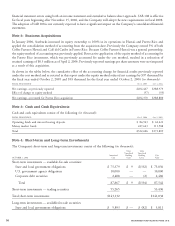Starbucks 2006 Annual Report Download - page 56
Download and view the complete annual report
Please find page 56 of the 2006 Starbucks annual report below. You can navigate through the pages in the report by either clicking on the pages listed below, or by using the keyword search tool below to find specific information within the annual report.Additional factors related to other-than-temporary impairment considered by management as of October 1, 2006,
included the following, by category:
State and local government obligations
The contractual terms of these securities do not permit the issuer to settle at a price less than the par value of the
investment, which is the equivalent of the amount due at maturity. These securities had a minimum credit rating of “A,”
and an average credit rating above “AA.”
Corporate debt obligations
The contractual terms of these securities do not permit the issuer to settle at a price less than the par value of the
investment, which is the equivalent of the amount due at maturity. These securities had a minimum and average credit
rating of “A.”
There were no realized losses recorded for other than temporary impairments during fiscal years 2006, 2005 or 2004.
Trading securities are comprised mainly of marketable equity mutual funds that approximate a portion of the Company’s
liability under the Management Deferred Compensation Plan, a defined contribution plan. The corresponding deferred
compensation liability of $64.6 million in fiscal 2006 and $47.3 million in fiscal 2005 is included in “Accrued
compensation and related costs” on the consolidated balance sheets. In fiscal years 2006 and 2005, the changes in net
unrealized holding gains/losses in the trading portfolio included in earnings were a net loss of $4.2 million and a net gain
of $2.4 million, respectively.
Long-term investments generally mature in less than three years.
Note 5: Derivative Financial Instruments
Cash Flow Hedges
Starbucks, which includes subsidiaries that use their local currency as their functional currency, enters into cash flow
derivative instruments to hedge portions of anticipated revenue streams and inventory purchases. Current forward
contracts, which comprise the majority of the Company’s derivative instruments, hedge monthly forecasted revenue
transactions denominated in Japanese yen and Canadian dollars, as well as forecasted inventory purchases denominated
primarily in U.S. dollars for foreign operations. The Company also has swap contracts to hedge a small portion of its
forecasted U.S. fluid milk purchases and futures contracts to hedge the variable price component for certain of its
price-to-be-fixed green coffee purchase contracts.
The Company had accumulated net derivative losses of $3.2 million, net of taxes, in other comprehensive income as of
October 1, 2006, related to cash flow hedges. Of this amount, $1.8 million of net derivative losses pertain to hedging
instruments that will be dedesignated within 12 months and will also continue to experience fair value changes before
affecting earnings. For the 52-week period ended October 1, 2006, net fair value losses of $0.1 million were recognized
into net earnings for derecognized cash flow hedges. No cash flow hedges were discontinued and no ineffectiveness was
recognized during the 52-week period ended October 2, 2005. Current contracts will expire within 24 months.
Net Investment Hedges
Net investment derivative instruments are used to hedge the Company’s equity method investment in Starbucks Coffee
Japan, Ltd. as well as the Company’s net investments in its Canadian and United Kingdom subsidiaries, to minimize
foreign currency exposure. The Company applies the spot-to-spot method for these forward foreign exchange contracts,
and under this method the change in fair value of the forward contracts attributable to the changes in spot exchange rates
(the effective portion) is reported in other comprehensive income. The remaining change in fair value of the forward
contract (the ineffective portion) is reclassified into earnings in “Interest and other income, net.” The Company had
52 STARBUCKS CORPORATION, FORM 10-K
























